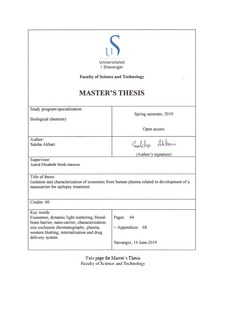| dc.contributor.advisor | Mork-Jansson, Astrid Elisabeth | |
| dc.contributor.author | Akbari, Saleha | |
| dc.date.accessioned | 2019-10-22T11:43:09Z | |
| dc.date.available | 2019-10-22T11:43:09Z | |
| dc.date.issued | 2019-06 | |
| dc.identifier.uri | http://hdl.handle.net/11250/2623711 | |
| dc.description | Master's thesis in Biological chemistry | nb_NO |
| dc.description.abstract | The investigation of exosomes as a cell-mediated delivery system for the delivery of nucleic acids, proteins and low molecular-weight therapeutic drugs increased during the past two decades. The potential of exosomes as drug delivery vesicles has enticed a significant attention due to the elucidation of their advantages and the impressive capacity they have. Here, exosomes were characterized, standard preservation determined and internalization of exosomes to human cerebral microvascular endothelial cells investigated.
In this project, vesicles from human plasma were isolated by size exclusion chromatography. Isolated vesicles were characterized as exosomes by applying different methods prior to further experiments. Vesicles in the size-range 30 -100 nm were indicated in dynamic light scattering measurements, which was the expected size for exosomes. The exosome protein marker, HSP70 was detected in the western blotting. Furthermore, the labeled exosomes were visualized by a laser scanning confocal microscopy.
The characterization of isolated vesicles by dynamic light scattering showed homogenous fractions of vesicles. The downstream identification of HSP70, suggested that the isolated vesicles might be indeed exosomes. Dynamic light scattering measurements and measuring absorbance of lipids and proteins present in exosomes suggested that the size, homogeneity and the total content of exosomes were preserved better at room temperature and 4C than storage at - 80C and - 20C.
The successful characterization of isolated vesicles allowed exosomes uptake assays to be analyzed by confocal microscopy. Pre-stained exosomes were integrated into a human cerebral microvascular endothelial cell line as a model for the human blood-brain barrier, and internalization of exosomes into the cells was assessed by confocal microscopy. The results suggested possible uptake of exosomes into human cerebral microvascular endothelial cells. However, the exact localization of exosomes in the cells remained unclear. | nb_NO |
| dc.publisher | University of Stavanger, Norway | nb_NO |
| dc.relation.ispartofseries | Masteroppgave/UIS-TN-IKBM/2019; | |
| dc.subject | biokjemi | nb_NO |
| dc.subject | biochemistry | nb_NO |
| dc.subject | biologisk kjemi | nb_NO |
| dc.subject | epilepsi | nb_NO |
| dc.subject | exosomes | nb_NO |
| dc.title | Isolation and characterization of exosomes from human plasma related to development of a nanocarrier for epilepsy treatment | nb_NO |
| dc.type | Master thesis | nb_NO |
| dc.subject.nsi | VDP::Mathematics and natural science: 400::Basic biosciences: 470::Biochemistry: 476 | nb_NO |
